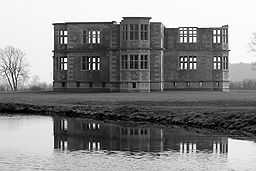Lyveden New Bield
| Lyveden New Bield | |
| unfinished country house | |
 The Unfinished Lyveden New Bield | |
| Country | England |
|---|---|
| State | Northamptonshire |
| Region | East Midlands |
| District | East Northamptonshire |
| Municipality | Aldwinkle St Peter |
| Location | within the parish of Aldwinkle St Peter |
| - coordinates | 52°27′25″N 0°33′12″W / 52.45694°N 0.55333°W |
| Style | unfinished summer house |
| Material | Structure constructed from stone |
| Founded | circa 1604–05 |
| Owner | Owned by the National Trust |
| Visitation | Building has 9 steps to a low entrance. The grounds are partly accessible, grass and uneven paths (Opening times vary, see NT web site) |
 | |
| Map Ref: SP9885 | |
Lyveden New Bield (sometimes called New Build) is an unfinished Grade I listed Elizabethan summer house in the parish of Aldwinkle St Peter in the county of Northamptonshire, England, owned by the National Trust. In 2012, the National Trust acquired Lyveden Manor which lies alongside New Bield. Both properties used to be one estate owned by the Tresham family in the 15th and 16th centuries. The trust is considering how to make use of the new acquisition.[1]
Construction
It was constructed for Sir Thomas Tresham, the fervent Roman Catholic of Rushton Hall, and is thought to have been designed by Robert Stickells. The exact date is unknown but can be estimated to circa 1604–05, the year of Tresham's death. The New Bield was on the estate of Tresham's second home Lyvedon Old Bield.
Just as at Tresham's smaller folly Rushton Triangular Lodge, his principal estate, the New Bield has a religious design full of symbolism. Designed on a plan reminiscent of a Greek cross, the facades have a strict symmetry. The building has two floors above a raised basement, with mullioned and transomed windows. Each floor had three rooms with a staircase in the south projection of the cross. The exterior of the building is decorated by friezes of a religious nature. The metopes contain the emblems and motifs found also at the triangular lodge, such as the "IHS" christogram.
Purpose
The house was obviously meant for occupation as not only does it have a great hall and parlour on the first floor and kitchen and buttery in the basement, but also a bedroom on the upper floor. The building was probably never intended for full-time occupation. Too close to the main house for use as a hunting lodge, it may have been intended for use as a "Secret House"—keeping a secret house was a custom of the 16th century. Often within a mile of the main house, the secret house was a place where the head of the household would retire for a few days with a minimum of servants, while the principal house was thoroughly cleaned, and bearing in mind the sanitation of the time, fumigated. Similar examples of "secret houses" exist at Leconfield and Warkworth where their use for this purpose has been well documented.
Lyveden Old Bield
Lyveden Old Bield, the once grand principal house of the estate, had belonged to the Tresham family from c.1450. Today, little remains and what does was probably built by Thomas Tresham's grandson Lewis. The gatehouse has been removed to Fermyn Woods Hall, and the staircase has been transported to America. One wing remains with mullioned windows.
The Tresham Family and The Gunpowder Plot
Sir Thomas Tresham died in 1605 following decades of religious persecution, his once vast wealth having been severely depleted. His son Francis Tresham inherited the estate, but within the same year, along with his cousins Catesby and Wintour, became involved in the Gunpowder Plot. Thus, within a year the estate had a third owner, Francis's son Lewis Tresham. The estate was managed by Lewis's mother until her death in 1615.
After this Lewis Tresham, a spendthrift, lost the remaining family wealth. The estate was eventually sold following the death of his son in 1643.
National Trust
Lyveden New Bield was never completed or used. It remains exactly as it was when the builders left following Sir Thomas Tresham's death. Evidence of the planned terraces and water garden remain. Today, it is in the care of the National Trust.
In 2010, National Trust experts studying photographs taken by the Luftwaffe during the Second World War discovered the remains of an Elizabethan fruit garden in the grounds of Lyveden New Bield.[2] The gardens were subsequently upgraded to a Grade I listing by English Heritage.[2]
References
- ↑ "Re-uniting the old with the new", National Trust Near you - East Midlands, Summer 2013: p4
- ↑ 2.0 2.1 Gray, Louise (2010-11-06). "Photos taken by the enemy in Second World War shows lost Tudor garden". Telegraph. Retrieved 2010-11-06.
External links
| Wikimedia Commons has media related to Lyveden New Bield. |